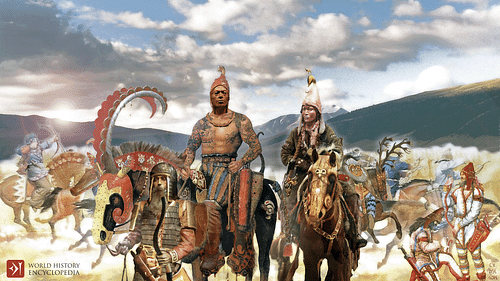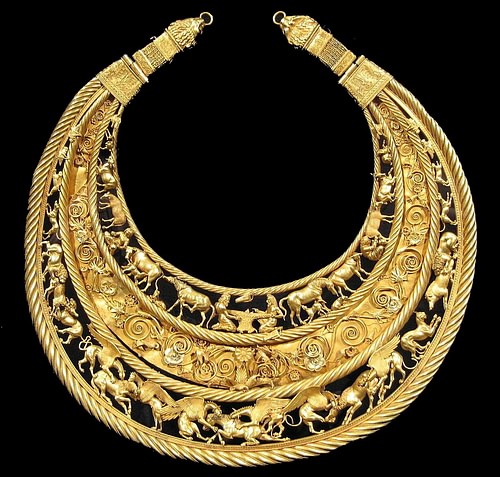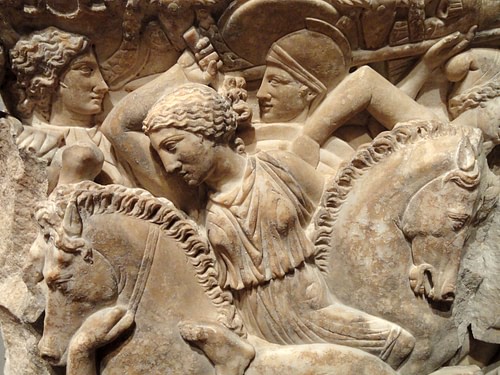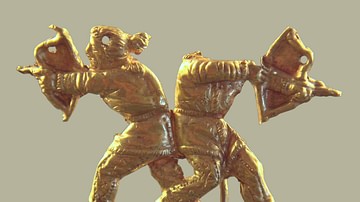
The Scythians were a nomadic people whose culture flourished between the 7th and 3rd century BCE in a territory ranging from Thrace in the west, across the steppe of Central Asia, to the Altai Mountains of Mongolia in the east. This covers an area around 4000 kilometers (2500 mi) in length. The geography of the open plains steppe, desert steppe, and forest-steppe expanses over which they ranged was conducive to a pastoral rather than a settled way of life involving agricultural production. As a result, these Steppe nomads had few urban centers, and had a nomadic lifestyle; riding horses, tending herds, and living in covered wagons.
Origins
While there is much debate about the origins of the Scythian populations, "Herodotus claims, and most modern scholars agree, they moved [west] from Asia into Europe by way of the great steppe corridor." (A. Yu Alexeyev, Scythians, 23) Yet, in the 1st century BCE, the Greek historian Diodorus Siculus, states the Scythians at first moved north from the Araxes river of Armenia. Another modern view is they moved south "in several waves from the Volga-Ural steppes into the north Black Sea" (A.I. Melyukova, Scythians and Sarmatians, 99). Writing in the 5th century BCE, Herodotus also shows the Sarmatians, splitting from the Black Sea Scythians, moving east. Then recent archaeological discoveries at Tuva in the Altai mountains, which date Scythian settlement to the late 9th century BCE, suggest early origins in the east. However, as 1st-century CE Chinese chroniclers speak of their red hair and blue eyes, their Caucasian features and Indo-European language support Bronze Age origins in the west, likely from the Celts.
Considering the fluidity of movement the steppe of Central Asia allows, it is not surprising so many declared migrations from different locations make pinpointing beginnings difficult. Ultimately, it is altogether possible, after an early far-reaching expansion from the west, there were in fact subsequent migrations from many points of origin. While their origin is debated, a general consensus identifies Scythian cultures of the Eurasian Steppes to be mostly comprised of four main groups:
- Pontic Scythians, around the Black Sea
- Sarmatians, from the northern Caspian Sea and Don and Volga River areas, in present-day Russia
- Massagetae in the desert steppe of Central Asia
- Sakā in east Central Asia
All four had a common cultural identity expressed in their warrior nomadism, their form of government, and unique art and dress.

Scythian Warfare
Scythian military equipment included a wide array of weapons. Besides shooting arrows from horseback, they also used battle axes, maces, lances, swords, shields, and for personal protection, scale armor, and helmets. Because of their collective ability to stay on the move, and with nimble cavalry, Herodotus says the Scythians were "invincible and impossible to approach" (Histories, 4.46). With such weapons and tactical ability, it is not surprising different nations often solicited Scythian military services.
In 490 BCE, Sakā mounted archers assisted the Persians against the Greeks at the Battle of Marathon and again at the Battle of Plataea in 479 BCE. Scythian warriors were similarly among the roll call joining Darius III (r. 336-330 BCE) against Alexander the Great (356-323 BCE) at the Battle of Gaugamela in 331 BCE. Appian, the Roman historian, shows "Scythian princes" from the Black Sea, instrumental in Pompey’s (106-48 BCE) defeat of Mithridates VI (r. 120-63 BCE) in 63 BCE. (Mithridatic Wars, 17.119) Moreover, as cousins and neighbors of the Parthians, the Scythians came to Parthia’s aid, when after dynastic trouble, the Parthian king Sinatruces I (r. c. 75-69 BCE) was installed to the throne with Scythian help. According to Cassius Dio, the Scythians also played a key role in helping Artabanus II (r. 12-38/41 CE), himself half Scythian, secure Armenia for Parthia. (57.26) Tacitus supports this claim showing Artabanus "collecting auxiliaries in Scythia" before joining battle. (Annals, 6.44.1)
However, the Scythians were not just kingmakers or potent allies. Scythia’s most spectacular victory was perhaps against the Persian Achaemenid Empire. With a strategy of attrition - in leading the enemy deep into friendly territory, stretching supply lines, then with hit-and-run and ambush tactics finishing their opponent off with arrows shot from horseback - the Scythians thwarted Darius the Great's (r. 522-486 BCE) incursion into Scythian territory. That gave them the reputation of being invincible. Adding to that success, Ateas (429-339 BCE), king of the Pontic Scythians, expanded Scythian interest into Thrace, establishing Scythia’s westernmost reach from the Don to the Danube.
After Ateas’ defeat and death at the hands of Phillip II of Macedon (r. 359-336 BCE) in 339 BCE, then getting caught in a trap at the river Jaxartes by Alexander the Great, the Scythians would never again recover their reputation as unconquerable. More blows came when the Scythians tried to take over the Greeks' Black Sea trade monopoly by attacking their colonies. Coming to the Greeks' rescue at the end of the 2nd century BCE, Mithridates VI dealt the Scythians a devastating defeat, as would the Romans in 63 CE when the Scythians again attacked the Chersonese. Finally, during the 4th century CE, the Scythians would completely disappear from the historical record when they were devastated by the Huns and assimilated by the Goths.
Scythian Government
While Herodotus refers to Scythian 'kings', and some by name, like with most tribal people, Scythian government was more a confederation of tribes and chiefs. Scythia’s confederated tribal structure is disclosed in Herodotus’ account of Persia’s invasion of Scythia when Darius taunted Scythia’s high king, Idanthyrsus, to stand and fight "or come to terms with your master." Idanthyrsus answered, saying that was not Scythia’s way of war; they would fight on their own terms. But when other "Scythian kings" heard Darius’ threat, they were apoplectic. These kings immediately implemented hit-and-run tactics. They then called for the destruction of the bridge the Persians would use to make their escape. Though the Scythians were unsuccessful in destroying the bridge, the kings call for action caused Darius’ withdrawal. (Histories, 4.126-142) Ultimately Herodotus’ account reveals that while a high king or chief represented the Scythian nation in the messaging between notables, other subchiefs also voiced their opinion and had a significant say in implementing action.
Just as important as their tribal structure, the communal organization of the Scythian military would have been an unsung part of their success. A golden beaker manufactured in the 4th century BCE from the Kul’-Oba kurgan (burial mound) in Crimea shows bivouacked soldiers. While two, with spears and bows at the ready, appear to contemplate their fate in upcoming action, one demonstrates how to string a bow; one removes his comrade’s tooth, while another bandages a fellow’s hurt leg. Another artifact in gold relief from the same kurgan demonstrates a common ritual where two warriors drink together from a horn. Such depictions reveal ways of life intended to instill a shared purpose and camaraderie among soldiers where individuals fighting for friends against foe create a united, more resilient front. Nevertheless, while Scythian loyalty between soldiers was indeed robust, group loyalty was to their tribe and chief.
Nomadism & Scythian Architecture
While the Scythians are not known for their infrastructure, that does not mean they lacked architectural types to suit their needs. Though it is widely believed they were wholly nomadic, Herodotus mentions two other types of Scythians: the "royal" and the "farming" kind. More than subsistent cultivators, some farmers, in fact, sold or exported their products. Not only would these have built permanent homes but, since their efforts were likely cooperative, they also would have developed settlements. North of the Black Sea in today’s Dnieper river vicinity, Herodotus mentions farmers inhabiting a land "three days journey" wide and "eleven days voyage" long (Histories, 4.17-20). The size of this district reflects a significant demand for grain products. Architecturally, such enterprises would also require a system of warehouses for storage and roads to points of transfer.
As to the Royal Scythians, while we have the architecture of their burial mounds called kurgans of carefully padded earthworks and catacombs, it appears they also resided with a degree of permanency in fortified settlements. The size of the earthworks of the Bel’sk fortification in the Dnieper river valley in Ukraine not only reflects the surmount of a significant superstructure (32 km or 20 mi in circumference) but indications are it was a center of crafts, wealth, and widespread trade. Even so, as ancient sources attest, the Scythians were mostly nomadic. More than one source mentions their houses on wheels. These covered house-wagons were pulled by teams of oxen and could have two or three rooms. Depending on the rank of the dweller, floors and walls could be opulently adorned. Moreover, when gathered, the house-wagons would have the appearance of a city.
Scythian Culture: Art, Music, & Dress
Much of what is learned about Scythian culture comes from recent kurgan finds north of the Black Sea. While ancient written sources focus on their nomadic warlike character, Scythian burial goods add another layer of understanding to their remarkable cultural sophistication and social vibrancy. Besides the level of intricate craftsmanship in glittering gold, many pieces tell a life story and so a comb is not just a comb but is crafted to show warriors in fierce combat. A pectoral or gorget, from the Tolstaya mogila kurgan, that shows in the upper register, with exquisite segmented detail, scenes from daily life: the milking of a ewe, two men sewing a shirt, calf and colts nursing. In contrast, the lower register displays dramatic prey/predator scenes of cats taking down a stag and griffins biting and clawing at horses. Then in choice places toward the neck are miniature goats, rabbits, dogs, grasshoppers, and birds.

Thus the Black Sea artifacts offer unique, sometimes dramatic, snapshots of Scythian fashion, interests, beliefs, habits, and daily life-visuals like few burial goods do. Many, like the gorget, have prey/predator themes while recumbent cats or reclining stags were also common. Scythian penchant swung between the remarkably realistic capturing of subject matter in mid-action and the abstract rendering of reality. Thus a stag or cat could be accurately portrayed or uniquely stylized.
Equal to their imaginative taste in gold, "the frozen tombs of the Altai provide an incomparable vision of the sheer exuberance of nomad dress: the love of bright, contrasting colors and intricate decorations formed by stitching, embroidery, and the attachment of leather cut-outs" (Cunliffe, 207). Dress items include intricately embellished shoes, leggings, sleeves, and a ladies cape with a fur border. Likewise, the sophistication of their garments was equally matched by an affinity for tattoos. Tattoo connoisseurs today would appreciate the shoulder-to-hand artistry displayed on the arms of one individual at Pazyrk. Indelibly tattooed are abstract images of curled cats, stags, rams, antelope, and goats.
Additionally, while the Black Sea discoveries also reveal the practical choice of trousers and tunic for horse people in a cold climate, they also show Scythia’s love of music and dance. Some items show erotic dancers (again expertly captured in mid-action) swaying to the music. At the Sachnovka kurgan, a golden headband showing a man playing the lyre was found. Pan pipes made from bird bones were found at kurgan 5 at Skatovka. In several tombs at Pazyryk, ox-horn drums were unearthed, and an amazing find of a harp-like instrument that had at least four strings comes from kurgan 2. Barry Cunliffe describes it as "made from a single hollowed-out wooden resonator, the middle part of the body was covered by a wooden sounding board, while sounding membranes were stretched over the open part of the body" (226-27). The tones issued forth from this instrument by a skilled musician must have been remarkable.
Religious Origins
One of the things the Scythian kurgan finds reveal is a belief in the afterlife. Besides objects of art, items placed within the mounds for the deceased elite included weapons, armor, parts of wagons, carpets, textiles of different sorts, household items, foodstuffs, and wine sealed in amphorae. Such care and provision for their dead reflect as Renate Rolle says, "an expectation of the hereafter" (The Scythians, 118).
Like all ancient cultures, worship and symbolism of the elements would have been an integral part of the Scythian belief system. With the flat expanse of the steppe over which they trod, a prominent characteristic in daily life would have been the sky as it met the earth at the horizon. Another manifest feature from which the Eurasian steppe offers little escape would have been the sun. Then there was that of fire. Providing security against wild beasts at night and everyday practical utility in cooking and metallurgy, fire in ancient times was essential and held considerable symbolic sway. It is not surprising then that the earth, sky, sun, and fire came to have particular theological value for the Scythians. And not surprising that, in his rebut to Darius, Idanthyrsus would claim Hestia (goddess of fire) and Zeus (god of the sky) were the only gods to which he would bow (Herodotus, Histories, 4.127.4.).
Herodotus relates eight deities the Scythians worshiped. Besides Hestia and Zeus, known by the Scythians as Tabitha and Papaeus, there were Api (mother earth), Goetosyrus (Apollo), and Argimpasa (Aphrodite). Though Herodotus omits their Scythian names, he also mentions Hercules, Ares, and Poseidon. These gods represented elements with which the Scythians were familiar: Ares was associated with war and Apollo with the sun. The earth-meets-sky visual expressed itself in the belief, when the sky god, Papaeus, made union with Mother Earth, all other gods were born. While little is known about her, it is believed the Scythian equivalent to Aphrodite was Argimpasa, cognate of Arti, the Iranian goddess of material abundance. Finally, concerning an essential element of their military success, the horse, Herodotus mentions Thagimasadas as equivalent to Poseidon, although not as god of the sea but as patron of the horse.
While Herodotus understood Scythian’s belief from his perspective of the Greek pantheon, he says the Scythians had no images, altars, or temples. And indeed, the kurgan finds reveal few gods, and then, only of Argimpasa, their mother-goddess. As Cunliffe mentions, "The deities of the upper ranges of the pantheon do not seem to have been anthropomorphized, or at least no certain depictions of them are known" (276).
Scythia’s Warrior-Women: The Amazon Connection
Finally, an amazing aspect in the study of Scythia is the eminent role women played in the military and political life of their people. Unprecedented until modern times, it appears some gained - as a group - social status equal to their men. While the telling of the Amazons finds its way into modern lore (Wonder Woman), the reality of their history has long been debated. Herodotus’ account tells the story of a foreign race of warrior-women coming to the shores of Scythia. As a group, they maintained their independence but eventually intermingled with a band of young Scythian men sent to them by Scythian elders. Though they spoke different languages, the two groups journeyed east to make their own tribe. Herodotus claims the Sarmatians were the result of this union and spoke a hybrid Scythian tongue. Moreover, these fierce warrior-women maintained their independence by following their ancient ways, often hunting on their own and warring alongside their men. They also forbade their daughters from marrying until they had killed a man in combat. (Histories, 4.110-117)
Appian validates the sovereign/warrior status of Scythian women. When describing Pompey’s triumph for defeating Mithridates VI, he includes among the procession of captured kings and generals, "female rulers of Scythia" (Mithridatic Wars, 17.116-17). The fact Appian mentions female rulers, plural and contemporary, indicates a broad, shared, common, and co-operative status of rulership. Additionally, Herodotus’ reference of Tomyris, the Scythian warrior-queen, defeating Cyrus the Great (c. 600-530 BCE) in battle centuries earlier, again suggests a tradition of female sovereignty (Histories, 1.205-14).
The record of archaeological sites as well indicates broad warrior, if not sovereign status, for Scythian women. In 1993, in the easternmost reaches of the Scythian confederation at Ak-Alakha on the Ukok plateau in the Altai mountains, excavators found a burial site of a rich Scythian female. That she was the central figure at the site, buried with objects of status, surrounded by six saddled horses, makes it likely she was at the least one of the principal elite of her people. Finally, according to Cunliffe, in Sarmatian territory, "one-fifth of the excavated warrior burials dating from the fifth to fourth centuries are female, while in Scythian territory more than forty female warrior burials are known" (219).











